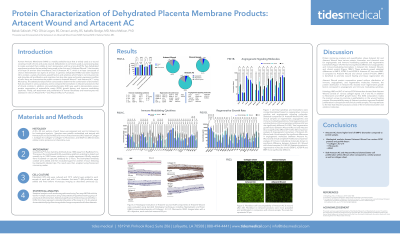Laboratory Research
(LR-046) Protein Characterization of Dehydrated Placenta Membrane Products: Artacent Wound and Artacent AC
Friday, April 28, 2023
7:15 PM - 8:30 PM East Coast USA Time

Olivia Logan, BS; Mora Melican, PhD; Denae Landry, BS; Isabella Sledge, MD
Introduction: Human Amniotic Membrane (hAM) is a readily available tissue that is widely used as a wound covering in both chronic and acute wounds. Dehydration is commonly used as a processing step to create a product that is stable at room temperature and has a long shelf life.
Two dehydrated membrane products that are widely being used in the clinic are (i) Artacent Wound, that consists of bi-layer of amnion dried membrane, and (ii) Artacent AC, which is tri-layer composed of a chorion layer between two layers of amnion.
In general, dehydrated hAMs have been reported [1] to contain a variety of proteins, growth factors and cytokines which help to not only promote and stimulate cell proliferation, migration, but also alter gene and protein expression profiles of cells.
Here, we characterize the protein content in Artacent Wound and Artacent AC using Microarray analysis.
This analysis provides further insight into the protein composition of hAM products currently in use in the clinic as wound coverings.
Methods: The following microarray was performed per manufacturer instructions: Ray Biotech Quantibody Human Cytokine Antibody Array 1000.
Results: A significant difference in regenerative growth factors was found between Artacent Wound and Artacent AC with Artacent AC having more regenerative factors. FGF-4 (Fibroblast growth factor) concentration is significantly different between Artacent AC and clinical control with Artacent AC containing a higher concentration. Regenerative marker, BMP-5, is found to be significantly different between Artacent Wound and Artacent AC, with Artacent AC having higher concentration.
Discussion:
Two dehydrated membrane products that are widely being used in the clinic are (i) Artacent Wound, that consists of bi-layer of amnion dried membrane, and (ii) Artacent AC, which is tri-layer composed of a chorion layer between two layers of amnion.
In general, dehydrated hAMs have been reported [1] to contain a variety of proteins, growth factors and cytokines which help to not only promote and stimulate cell proliferation, migration, but also alter gene and protein expression profiles of cells.
Here, we characterize the protein content in Artacent Wound and Artacent AC using Microarray analysis.
This analysis provides further insight into the protein composition of hAM products currently in use in the clinic as wound coverings.
Methods: The following microarray was performed per manufacturer instructions: Ray Biotech Quantibody Human Cytokine Antibody Array 1000.
Results: A significant difference in regenerative growth factors was found between Artacent Wound and Artacent AC with Artacent AC having more regenerative factors. FGF-4 (Fibroblast growth factor) concentration is significantly different between Artacent AC and clinical control with Artacent AC containing a higher concentration. Regenerative marker, BMP-5, is found to be significantly different between Artacent Wound and Artacent AC, with Artacent AC having higher concentration.
Discussion:

.png)